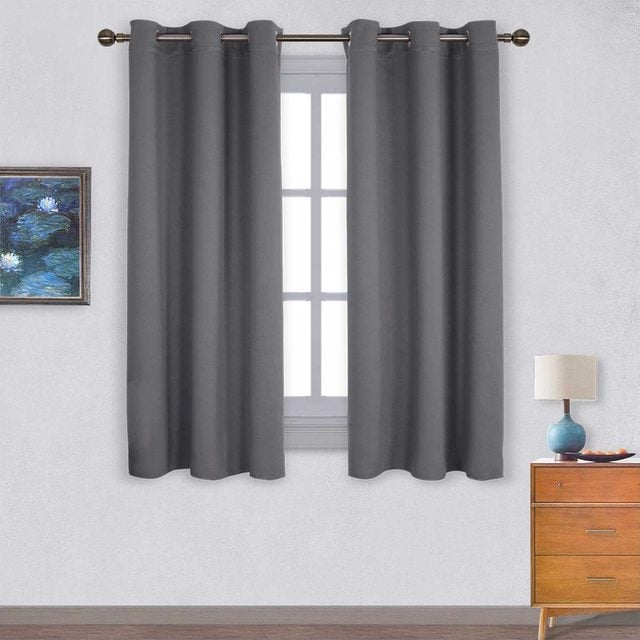Don't live in an under-insulted home just because you don't want to destroy your walls.
Our editors and experts handpick every product we feature. We may earn a commission from your purchases.Learn more.
Don't live in an under-insulted home just because you don't want to destroy your walls.
Our editors and experts handpick every product we feature. We may earn a commission from your purchases.Learn more.
 via amazon.com
via amazon.com
Elaborate window treatments have been out of style for decades. But if you’re willing to install simple thermal curtains, they will help keep rooms with windows warmer in winter and cooler in summer. Look for curtains described as “thermal” or “insulating.”

Electrical outlets and switches may be small, but they allow lots of heat to pass out of the home and cold air to enter. When you add up all of the outlets and switches in a house, that’s a lot of uninsulated space! Luckily there’s a simple fix: Install foam gaskets behind outlet and switch covers to help block heat loss. An infrared thermograph may still show some loss, but carefully-applied spray foam can reduce it to near zero!
 artursfoto/Getty Images
artursfoto/Getty Images
Heat rises, so it makes sense that more heat escapes through the attic than anywhere else in your home. Insulating your attic can reduce that more than almost any other measure. Attics are often unfinished, so adding insulation rolls should be simple. Another alternative is adding spray foam to open areas under the roof where there’s no other insulation.
If you live in an area with warm summers, more insulation as a radiant barrier also makes sense. Radiant barriers feature material that reflects heat instead of absorbing it into your home, reducing air conditioning bills. Here are a few tips for insulating A/C lines.
 Family Handyman
Family Handyman
Insulating water pipes reduces heat loss and can raise your water temperature two to four degrees F. That helps the water from your tap or shower heat faster so you don’t need to run it as long, saving water. Water pipe insulation is cheap and easy to install in most places. Simply slide the insulation around the existing pipe and you’re all set.
 via amazon.com
via amazon.com
Damaged window and door seals are among the leading causes of heat loss. A smoke leak detector shows exactly where the loss is coming from. A simple DIY solution to reducing window and door energy loss is new weatherstripping and door sweeps. Both should seal any gaps in window openings and under your door.
 Family Handyman
Family Handyman
Lighting openings are an often overlooked source of energy loss. Most thermal detectors can show if you are losing heat through these openings. If so, there are ways to insulate them safely. Be sure you have a 3-in. space between the lighting and the insulation for fire safety. If this isn’t possible, you may have to use airtight IC*-rated lighting.

Cracked and broken HVAC ducts cause substantial energy loss, so repairing and insulating them can help improve efficiency. Start by replacing or sealing open or poorly sealed ducts. To maintain temperatures in the longer duct areas, add insulation around the duct work. Proper sealing and insulating can save energy in warm and cold climates.
 Akchamczuk/Getty Images
Akchamczuk/Getty Images
An often-overlooked aspect of keeping your home insulated is moisture control. Moisture can destroy seals and dampen insulation, which causes compression. Through proper ventilation, you can limit moisture that can damage your insulation as well as your walls. Make sure your bathroom fans are functioning properly and the rest of your home has plenty of airflow. If it rains a lot where you live, you may need to install a vapor barrier insulation in the crawl space below your home.
 Family Handyman
Family Handyman
A top complaint about crawl spaces in the winter is cold floors. So insulating your floor is vital to maintaining temperatures in your home. If you have access to your crawlspace, insulate that area. Focus on the walls, not the ceiling. Choose rigid foam board insulation, installed with construction adhesive. If you lack a crawl space, consider a fiberboard underlay or polystyrene board under your tile or carpet.
 via amazon.com
via amazon.com
Your HVAC ducts are like veins; the places farther away from the heart get the least circulation. That’s where duct booster fans come in. Installing a duct fan booster in a line to a room furthest from your furnace boosts the flow, allowing your unit to work less to maintain a more equal temperature. Another alternative is to add a programmable thermostat-controlled vent which helps regulate temperatures from the vent itself. Insulate your exposed foundation walls for a more energy-efficient home.